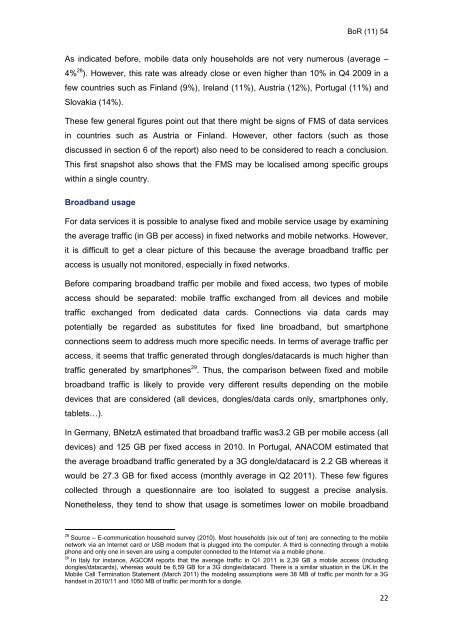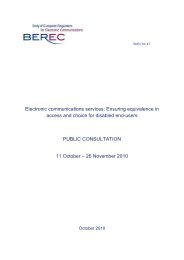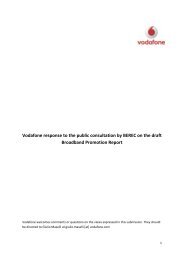BEREC REPORT ON IMPACT OF FIXED-MOBILE ... - berec - Europa
BEREC REPORT ON IMPACT OF FIXED-MOBILE ... - berec - Europa
BEREC REPORT ON IMPACT OF FIXED-MOBILE ... - berec - Europa
You also want an ePaper? Increase the reach of your titles
YUMPU automatically turns print PDFs into web optimized ePapers that Google loves.
BoR (11) 54<br />
As indicated before, mobile data only households are not very numerous (average –<br />
4% 28 ). However, this rate was already close or even higher than 10% in Q4 2009 in a<br />
few countries such as Finland (9%), Ireland (11%), Austria (12%), Portugal (11%) and<br />
Slovakia (14%).<br />
These few general figures point out that there might be signs of FMS of data services<br />
in countries such as Austria or Finland. However, other factors (such as those<br />
discussed in section 6 of the report) also need to be considered to reach a conclusion.<br />
This first snapshot also shows that the FMS may be localised among specific groups<br />
within a single country.<br />
Broadband usage<br />
For data services it is possible to analyse fixed and mobile service usage by examining<br />
the average traffic (in GB per access) in fixed networks and mobile networks. However,<br />
it is difficult to get a clear picture of this because the average broadband traffic per<br />
access is usually not monitored, especially in fixed networks.<br />
Before comparing broadband traffic per mobile and fixed access, two types of mobile<br />
access should be separated: mobile traffic exchanged from all devices and mobile<br />
traffic exchanged from dedicated data cards. Connections via data cards may<br />
potentially be regarded as substitutes for fixed line broadband, but smartphone<br />
connections seem to address much more specific needs. In terms of average traffic per<br />
access, it seems that traffic generated through dongles/datacards is much higher than<br />
traffic generated by smartphones 29 . Thus, the comparison between fixed and mobile<br />
broadband traffic is likely to provide very different results depending on the mobile<br />
devices that are considered (all devices, dongles/data cards only, smartphones only,<br />
tablets…).<br />
In Germany, BNetzA estimated that broadband traffic was3.2 GB per mobile access (all<br />
devices) and 125 GB per fixed access in 2010. In Portugal, ANACOM estimated that<br />
the average broadband traffic generated by a 3G dongle/datacard is 2.2 GB whereas it<br />
would be 27.3 GB for fixed access (monthly average in Q2 2011). These few figures<br />
collected through a questionnaire are too isolated to suggest a precise analysis.<br />
Nonetheless, they tend to show that usage is sometimes lower on mobile broadband<br />
28 Source – E-communication household survey (2010). Most households (six out of ten) are connecting to the mobile<br />
network via an Internet card or USB modem that is plugged into the computer. A third is connecting through a mobile<br />
phone and only one in seven are using a computer connected to the Internet via a mobile phone.<br />
29 In Italy for instance, AGCOM reports that the average traffic in Q1 2011 is 2,39 GB a mobile access (including<br />
dongles/datacards), whereas would be 6,59 GB for a 3G dongle/datacard. There is a similar situation in the UK.In the<br />
Mobile Call Termination Statement (March 2011) the modeling assumptions were 38 MB of traffic per month for a 3G<br />
handset in 2010/11 and 1050 MB of traffic per month for a dongle.<br />
22





